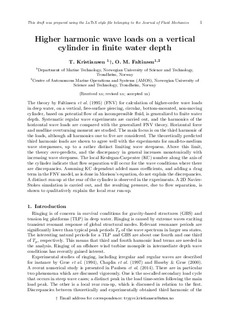Higher harmonic wave loads on a vertical cylinder in finite water depth
Journal article
Submitted version

View/
Date
2017Metadata
Show full item recordCollections
- Institutt for marin teknikk [3421]
- Publikasjoner fra CRIStin - NTNU [37703]
Abstract
The theory by Faltinsen et al. (1995) (FNV) for calculation of higher-order wave loads in deep water, on a vertical, free-surface piercing, circular, bottom-mounted, non-moving cylinder, based on potential flow of an incompressible fluid, is generalized to finite water depth. Systematic regular wave experiments are carried out, and the harmonics of the horizontal wave loads are compared with the generalized FNV theory. Horizontal force and mudline overturning moment are studied. The main focus is on the third harmonic of the loads, although all harmonics one to five are considered. The theoretically predicted third harmonic loads are shown to agree well with the experiments for small-to-medium wave steepnesses, up to a rather distinct limiting wave steepness. Above this limit, the theory over-predicts, and the discrepancy in general increases monotonically with increasing wave steepness. The local Keulegan-Carpenter (KC) number along the axis of the cylinder indicate that flow separation will occur for the wave conditions where there are discrepancies. Assuming KC dependent added mass coefficients, and adding a drag term in the FNV model, as is done in Morison’s equation, do not explain the discrepancies. A distinct run-up at the rear of the cylinder is observed in the experiments. A 2D NavierStokes simulation is carried out, and the resulting pressure, due to flow separation, is shown to qualitatively explain the local rear run-up.